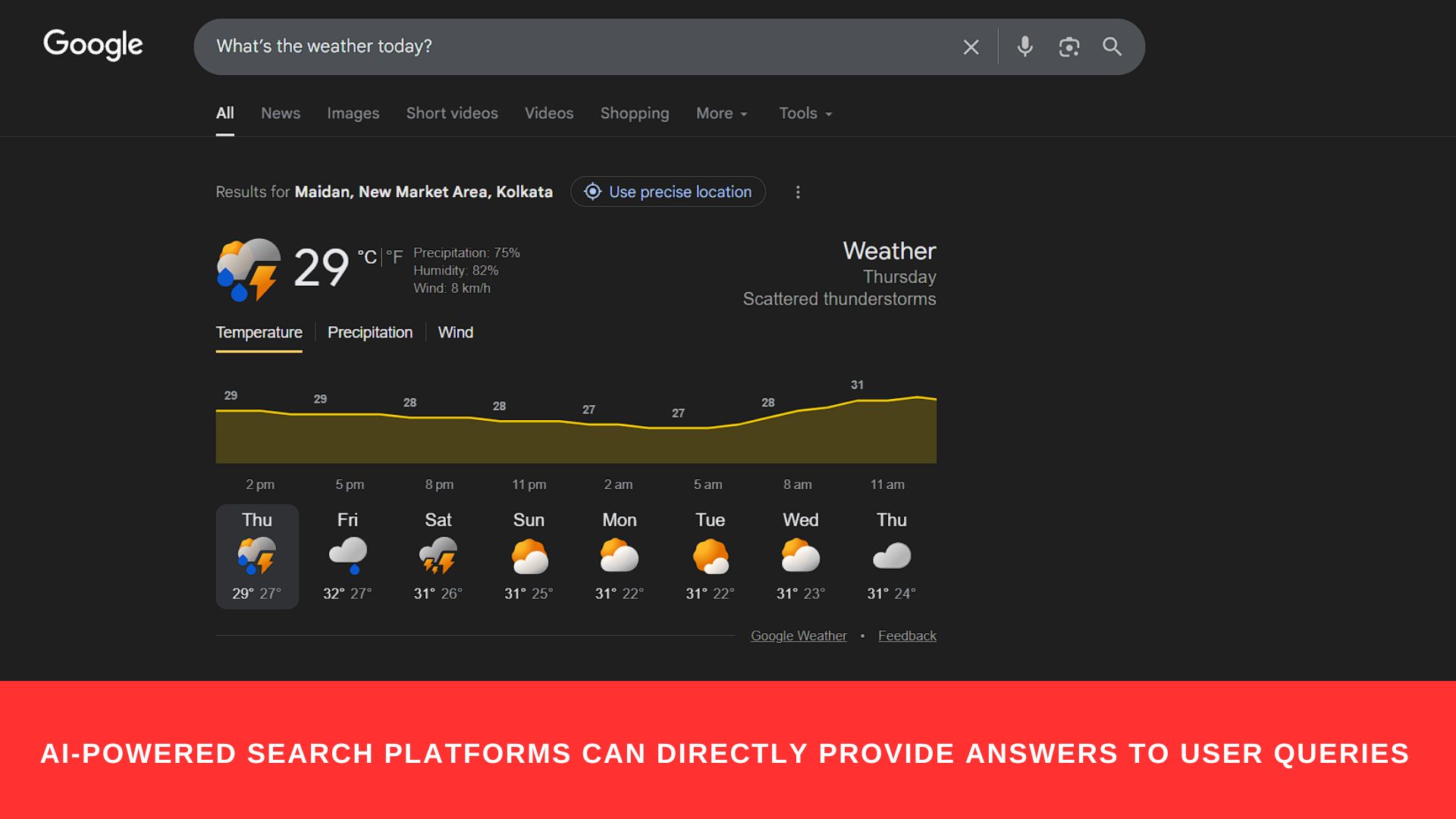Understanding Answer Engine Optimization
What is Answer Engine Optimization (AEO)? It’s the practice of optimizing your content so that AI-powered search platforms can directly provide answers to user queries, rather than just listing links. This is the essence of AI search optimization.
Unlike traditional SEO, which focuses on ranking web pages higher, AEO ensures your content becomes the direct answer that AI engines deliver.
Think of it this way: when you ask Siri “What’s the weather today?” or type a question into ChatGPT, the system gives you a direct, conversational answer, not a list of websites. AEO helps ensure your content is the source of that answer.

How Answer Engines Work
Answer engines process and deliver information differently from traditional search engines, relying on advanced AI technologies:
Natural Language Processing (NLP)
NLP helps these systems understand what you’re really asking, even when you phrase questions differently. It’s like having a conversation with a knowledgeable friend who gets your meaning, not just your exact words.
Large Language Models (LLMs)
LLMs act as the brains behind the operation. Trained on millions of web pages, these AI systems connect information from various sources to provide relevant answers, solidifying the need for effective AI search optimization strategies. When you ask a question, they pull from their vast knowledge base while citing the information source.
Real-time Retrieval (RAG)
Real-time Retrieval provides fresh information through a process called Retrieval Augmented Generation (RAG). This allows AI engines to access current data from search results, APIs, or external databases to ensure up-to-date and accurate answers.
Key Differences Between AEO and Traditional SEO
Understanding these differences is crucial for modern digital marketing strategies:
Aspect
Traditional SEO
Answer Engine Optimization (AEO)
Primary Goal
Rank high in search results pages
Appear as the direct answer in AI responses
Content Focus
Keyword-optimized articles
Conversational, question-based content
Success Metrics
Website traffic and click-through rates
Visibility in AI answers and voice results
Content Structure
Long-form, comprehensive articles
Concise, structured answers (40-60 words)
User Journey
Click-through to website required
Zero-click satisfaction
Platforms
Google, Bing, Yahoo
ChatGPT, Gemini, Perplexity, voice assistants
Aspect | Traditional SEO | Answer Engine Optimization (AEO) |
Primary Goal | Rank high in search results pages | Appear as the direct answer in AI responses |
Content Focus | Keyword-optimized articles | Conversational, question-based content |
Success Metrics | Website traffic and click-through rates | Visibility in AI answers and voice results |
Content Structure | Long-form, comprehensive articles | Concise, structured answers (40-60 words) |
User Journey | Click-through to website required | Zero-click satisfaction |
Platforms | Google, Bing, Yahoo | ChatGPT, Gemini, Perplexity, voice assistants |
Why AEO Matters in 2025
Why is AEO important for 2025? The search landscape is rapidly evolving:
- The Zero-Click Trend: In 2024, 60% of Google searches resulted in users never leaving the search results page. This “zero-click” trend means that getting your content featured as the direct answer is more valuable than traditional website traffic.
- The Rise of Voice Search: People are increasingly asking natural questions (e.g., “What’s the best way to…” or “How do I…”) rather than typing short keywords. AEO helps you capture this conversational search traffic.
Essential AEO Strategies for Beginners
1. Focus on User Intent and Questions
Start by understanding what questions your audience actually asks. Use tools like Google’s “People Also Ask,” Answer The Public, or your Google Search Console to identify common questions.
Structure your content around these key question formats:
- What is [topic]?
- How do I [accomplish task]?
- Why does [situation] happen?
- When should I [take action]?
2. Create Answer-First Content
Write content that provides direct, concise answers within the first 40–60 words of each section. This format is ideal for AI engines to extract as featured snippets or voice responses.
Effective Answer Structure:
- Lead with the direct answer.
- Follow with detailed explanation.
- Include supporting examples or data.
- Use bullet points and numbered lists for clarity.
3. Use Conversational Language
Write naturally, as people speak and ask questions. Instead of optimizing for “credit card debt consolidation,” optimize for the natural question “How do I consolidate my credit card debt?” This aligns with how users interact with AI chatbots and voice assistants. Get more info about Conversational Search: Voice, NLP, and Featured Snippet Strategies.
4. Implement Structured Data
Structured data (schema markup) is crucial for helping AI engines understand your content. The most effective schema types for AEO include:
- FAQPage Schema: For frequently asked questions.
- HowTo Schema: For step-by-step guides.
- Article Schema: For blog posts and news articles.
- QAPage Schema: For community Q&A content.
Use JSON-LD format for implementation, as it is the recommended standard.
5. Optimize for Featured Snippets
Featured snippets are a gateway to AI-powered answers.
- Use clear, descriptive headings (H2, H3 tags).
- Format information with bullet points, numbered lists, and tables.
- Provide direct answers in paragraph form.
6. Build Authority and Credibility
AI engines prioritize authoritative, trustworthy content. Strengthen your content by:
- Adding author bios and expertise credentials.
- Including publication and update dates.
- Citing reliable sources and statistics.
- Building quality backlinks.
- Regularly updating information.
Getting Started with AEO
Follow these steps to transition your strategy:
- Audit Your Current Content: Identify existing content pieces that already answer common questions—these are prime candidates for AEO optimization.
- Research Question-Based Keywords: Find long-tail, conversational queries related to your industry.
- Restructure Your Content: Reorganize to lead with direct answers, use clear headings, and implement proper formatting.
- Add Schema Markup: Implement relevant structured data to help AI engines categorize your content.
- Monitor and Adjust: Track your performance using Google Search Console and refine your strategy based on which content appears in AI-powered results.
Common AEO Mistakes to Avoid
- Keyword Stuffing: AEO favors natural language over forced keyword placement. [Related: Keyword Strategy for AEO]
- Overly Complex Answers: Keep responses clear and concise for AI extraction.
- Ignoring Mobile Optimization: Ensure fast loading and mobile-friendly design.
- Broken Structured Data: Regularly test your schema markup for errors.
- Outdated Information: AI engines prefer fresh, current content.
The Future of Search is Here
Answer Engine Optimization represents the evolution of search from a discovery process to an answer-delivery system. As AI-powered search tools become more prevalent, businesses that adapt their content strategy to AEO principles will maintain visibility in this new landscape.
To effectively manage this evolution, you must leverage the best AEO tools and platforms available today.
The key is simple: provide valuable, accurate, and conversational information that helps real people solve real problems.

